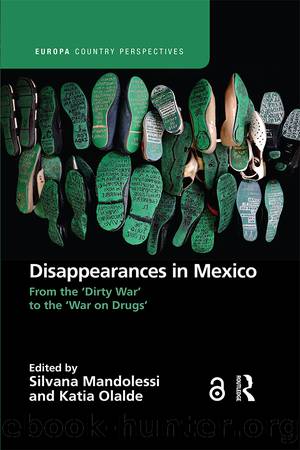Disappearances in Mexico by Unknown

Author:Unknown
Language: eng
Format: epub
Publisher: Taylor and Francis
Published: 2022-01-13T00:00:00+00:00
Final remarks
The analysis we have carried out illustrates the fruitfulness of the notion of violence regimes in understanding the logics of disappearance at a given time and place, as well as helping to better understand the pathways through which this kind of violence occurs.
In our analysis, it became evident that the logics of disappearance in the north-eastern Mexico are embedded in the diverse array of violences permitted under the operating regime. Localising these disappearances within the violence regime allowed us to call attention to the specific rules of violence in which disappearances became an acceptable part of the repertoire.
Analysis of north-eastern Mexico illustrates that the logics of disappearance are shaped by the features of the violence regimes in which they occur. The rules that structure violence in the region give meaning to the logics of disappearance. In our analysis of the pattern of disappearances in different times and places, we suggest that the question of the rules that decide violence is one of the analytical keys to figuring out how disappearance became generalised. This question is also crucial to supporting efforts to build truth and justice from these tragedies while so many shadows obscure where the disappeared are and who disappeared them. In the cases we looked at, the violence regime that prevailed was characterised by the operation of a variety of armed state agents from the three levels of government and armed non-state agents, mainly criminal groups. In this regime the different levels of government fight and/or cooperate with criminal groups and criminal groups dispute territory amongst themselves and with the state. At the centre of this are the civilians, especially those that are not part of the political, economic, and cultural elites, who become disposable populations under this regime of violence. To think about how different forms of violence are part of regimes, it is useful to ask about their rules, the actors that set these rules, the actors that use them and have access to violence, and the kinds of dynamics that form the context in which disappearances take place. However, building the specific mechanisms that link violence regimes and the logics of disappearance remains an ongoing effort.
In this scenario, different conflicts coexist and intersect in which state and non-state actors intervene. It is within this framework that the logics of disappearances make sense. The forms of access and use of violence by state and non-state agents are consistent with the logic of clandestine acts to eliminate one another. The circulation of violence reveals long-standing collaborative links between violent and non-violent state and non-state agents, whose patterns leave some groups of the population defenceless and disposable. These population groups are not random, they are made up of those who are considered disposable in the framework of this violence regime. This situation generates fear and mistrust among the population and reinforces the underreporting of crime.
However, many families get together and organise despite their fear. In Nuevo León and Coahuila, where there were long-standing civil society organisations, the families
Download
This site does not store any files on its server. We only index and link to content provided by other sites. Please contact the content providers to delete copyright contents if any and email us, we'll remove relevant links or contents immediately.
Killers of the Flower Moon by David Grann(3240)
Machine Learning at Scale with H2O by Gregory Keys | David Whiting(2293)
Will by Will Smith(2043)
Guns, Germs and Steel by Diamond Jared(1885)
Borders by unknow(1786)
The Room Where It Happened by John Bolton;(1721)
The Color of Law by Richard Rothstein(1575)
Once Upon a Broken Heart by Stephanie Garber(1486)
Water Rights and the Environment in the United States by John Burch(1414)
Friends, Lovers, and the Big Terrible Thing by Matthew Perry(1330)
Examples & Explanations: Administrative Law by William F. Funk & Richard H. Seamon(1326)
A Short History of War by Jeremy Black(1300)
HBR's 10 Must Reads 2022 by Harvard Business Review(1256)
Pharmacy Practice and The Law by Richard Abood(1254)
The Strength In Our Scars by Bianca Sparacino(1251)
That Every Man Be Armed by Stephen P. Halbrook(1237)
The Guarded Gate by Daniel Okrent(1220)
515945210 by Unknown(1209)
Injustices by Ian Millhiser(1199)
